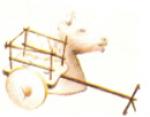Among the world's 4 most ancient cultures, India's Indus Valley or Harappa culture is most noteworthy. In India the only remains discovered are at Lothal and in Kutch at Dholavira. Both these sites are in Gujarat and are on world map too.
Lothal (Saragvala) is one of the most ancient sites of this ci vilization and its period is believed to be between BC 2450 to BC 1900. Situated about 80 km from Ahmedabad, it came to light in November 1954. As the note in the Gazetteer says, it seems to have been a Port at one time.
After the first human settlement at Lothal it seems that in about a century, around BC 2350 all the houses there were destroyed due to severe floods. Later on under the guidance of some intelligent leader the wal1s of the Fort were strengthened and the town was built on a higher plane. The facilities of docking ships 'were increased by erecting artificial docks. From the remains we also find that the town planning was also beautiful. The houses were large, there were baths in the homes, and pipes to carry water there, also there were sewage lines too. There were warehouse, market places and factories besides well laid out roads. These roads were wide enough to allow two vehicles to cross each other with ease, they were laid straight with bylanes cutting across at right angles. The houses were made from burnt bricks of large size. The ironsmiths and goldsmiths made use of round furnaces for their professions.
From the utensils found at Lothal we find that these were made of stone, clay, brass etc. These were decorated with beautiful designs. Sometimes human figures also can be seen on them. Some figures are with animal head and human body figures too. Among the animal figures, that of a bul1 is most prominent. Lothal seems to have good number of artists and artisans. We have also found considerable number of seals from Lothal. The people seem to have been very fond of beautiful jewelry. A measure-tape made from ivory that must have been used by the artisans has been found here. Within the public hall we have also found game similar to Indian Chess
The burial grounds were out of the walls, on the other side of the higher grounds, it seems. We have found some skeletons from here. One of them had a round brass earring. Two others had shell bangles in the hands. That indicates that they buried their dead. At one burial place two skeletons are found together.
The archeological remains show quite clearly that in the Indus Valley, especially at Lothal, a rich community resided and their religious or social traditions did not differ much from those followed by the Aryans. It is likely that the' Asuras' named in the Vedas probably referred to these people. When they came into India, the Aryas also came down to Gujaratregion. The non-Aryans were much ahead of the Aryans in their art and skilled crafts, besides science. On the other hand, the Aryas had progressed much more in the field of religion and philosophy besides Tapas. The imagination of the God in the Vedas, the principle of Pancha Tattvas or Five Elements, and the observations about Nature made by the Aryas are mind-boggling. The non-Aryans used to worship stone images, trees, serpents and animals. The Suryavanshi Aryas built their Ashramas in beautiful environments on the banks of the ocean or great rivers or in the forests, and purified the land and the climate with their chanting ofVedic Mantras and the fumigations of the Yagnas they performed. The Chandravamshi Aryas came down to Saurashtra by the water routes. For a very long time there were clashes between Aryas and non-Aryas, but gradually they began to exchange peaceful dealings and even married with each other, and ultimately this led to their fusion to such an extent that the two streams have become one since long.







